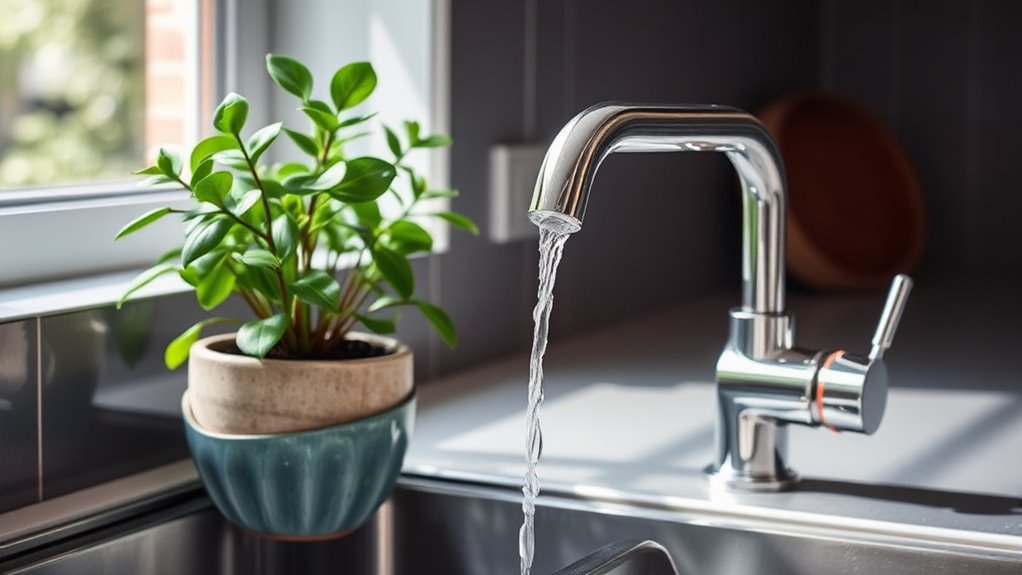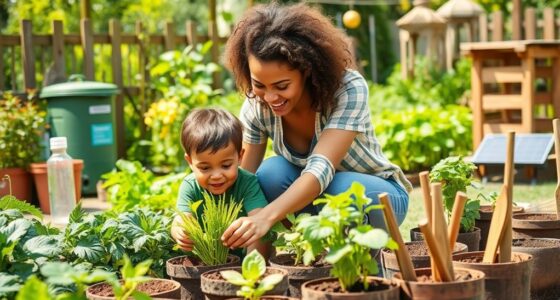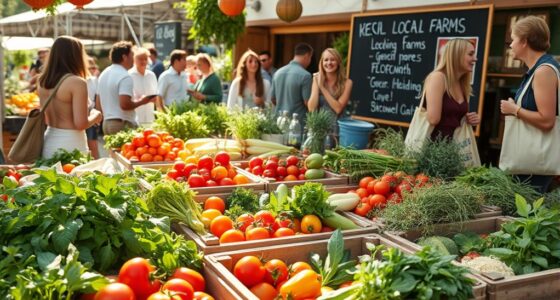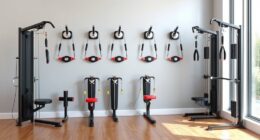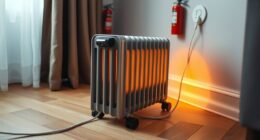To save water outdoors, guarantee your sprinklers are properly maintained by adjusting spray heads and fixing leaks, preventing waste. Use rain barrels to collect rainwater for your garden, reducing utility costs. Water early in the morning or late at night to limit evaporation, and mulch around plants to keep soil moist longer. Group plants with similar needs, and monitor your water use to catch leaks early. Keep exploring to discover even smarter ways to conserve water effortlessly.
Key Takeaways
- Water early mornings or late evenings to reduce evaporation and maximize efficiency.
- Install rain barrels to collect free rainwater for garden use, lowering utility bills.
- Adjust sprinkler heads to target only your yard, preventing water waste on sidewalks or driveways.
- Mulch around plants to retain soil moisture and decrease watering frequency.
- Regularly check and fix leaks in hoses and nozzles to prevent unnecessary water loss.
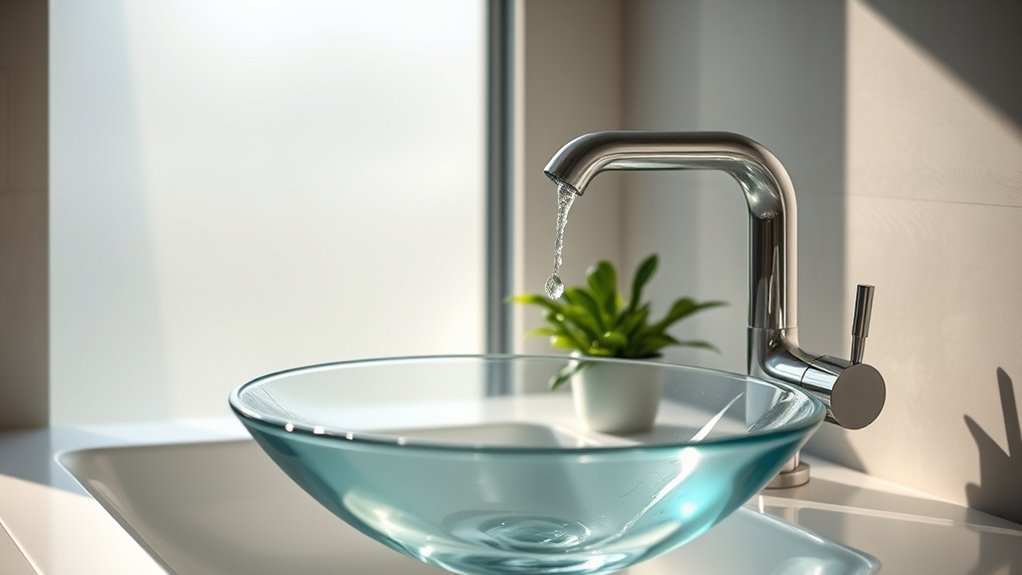
Conserving water is more important than ever, especially as droughts and rising utility costs become common concerns. You might think that watering your lawn or garden requires a lot of water, but small changes can make a big difference. One of the most effective steps is proper sprinkler maintenance. Regularly inspecting your sprinkler system ensures it’s working efficiently, preventing leaks and uneven watering. Adjusting spray heads so they only cover your yard—not the sidewalk or driveway—stops waste. If you notice puddles or dry patches, it’s a sign you need to fine-tune your system. These simple adjustments reduce water consumption and keep your landscape healthy.
Proper sprinkler maintenance prevents leaks, saves water, and keeps your landscape healthy.
Another smart move is to incorporate rain barrel use. Instead of relying solely on municipal water, collecting rainwater is a natural, eco-friendly way to keep your garden thriving. Installing a rain barrel beneath your downspout allows you to harvest rain during storms, giving you a free source of water for plants. Using this stored rainwater for watering reduces your utility bills and minimizes your household’s water footprint. It’s easy to set up and maintain, and it encourages a more sustainable approach to gardening. Plus, rain barrels help prevent stormwater runoff, which can carry pollutants into local waterways. Knowing the importance of water conservation can motivate you to adopt these practices.
Beyond these specific tools, timing your watering sessions is vital. Early mornings or late evenings are ideal because less water evaporates during cooler temperatures. This way, you get the most out of every drop. Avoid watering on windy days, as wind can blow water away, making your efforts less effective. Incorporate mulching around plants to retain soil moisture longer, reducing the need for frequent watering. You can also group plants with similar water needs together, ensuring you don’t overwater or underwater any section of your garden.
Educating yourself about your local weather patterns and soil type can further optimize your water-saving efforts. Understanding when and how much to water prevents waste and keeps your garden healthy. Keep an eye on your water meter to track usage and identify leaks early. Small steps like fixing leaky hoses or replacing old nozzles can add up over time. By combining proper sprinkler maintenance, rain barrel use, and mindful watering habits, you’ll considerably cut down on water waste. Not only will you save money, but you’ll also do your part in conserving this precious resource for future generations. These tricks might seem simple, but their impact is profound—making your home more sustainable and environmentally friendly.
Frequently Asked Questions
How Can I Measure My Household Water Usage Effectively?
To measure your household water usage effectively, consider installing smart meters. These devices provide real-time data, making it easy to track your consumption accurately. You can identify leaks or high-usage periods quickly by monitoring usage tracking through the smart meter’s app or display. Regularly reviewing this information helps you make informed decisions on conserving water and reducing your bills, ensuring you stay aware of your household’s water habits.
Are There Eco-Friendly Appliances That Save Water?
You can find eco-friendly fixtures and water-efficient appliances that cut down your water use. Look for low-flow showerheads, dual-flush toilets, and water-saving dishwashers or washers, which are designed to reduce consumption without sacrificing performance. These eco-friendly fixtures help you save water and lower your utility bills. Switching to water-efficient appliances is a smart move that benefits the environment and makes your household more sustainable.
What Are the Costs Associated With Installing Water-Saving Devices?
When considering water-saving devices, you need a cost analysis to understand the expenses involved. Installation expenses can vary depending on your home’s plumbing and the type of device you choose. While some models are inexpensive and easy to install, others may require professional help, increasing costs. Overall, investing in these devices can save you money on water bills long-term, making the upfront costs worthwhile.
How Do Water-Saving Tricks Vary by Climate or Region?
You’ll find that water-saving tricks vary widely depending on your region and climate. In areas prone to regional droughts, you’ll want to focus on climate adaptation strategies like xeriscaping or installing drought-tolerant plants. These methods help conserve water during dry seasons. In wetter regions, you might prioritize efficient irrigation systems to prevent overuse. Adjusting your water-saving practices to your climate guarantees you maximize conservation and resilience.
Can Water-Saving Practices Impact Water Quality or Safety?
Water-saving practices mainly target reducing usage, but they can impact water quality or safety if not managed properly. For example, less water flow might hinder effective water treatment, increasing the risk of water contamination. You should guarantee your plumbing and filtration systems are maintained well to prevent safety issues. Properly managing water use helps preserve quality, so always follow guidelines that promote both conservation and safe, clean water for your household.
Conclusion
Now that you’ve learned these water-saving tricks, you can make a real difference every day. Small changes add up, saving both water and money. Remember, “A penny saved is a penny earned,” so why not start today? By being mindful of your water use, you’re helping the planet and your wallet. It’s easy to make a positive impact—just a few simple habits can go a long way. So, go ahead and turn those tips into action!
